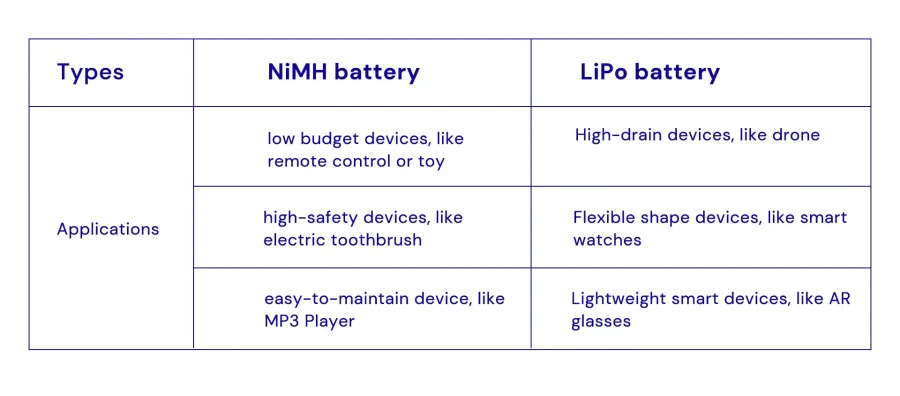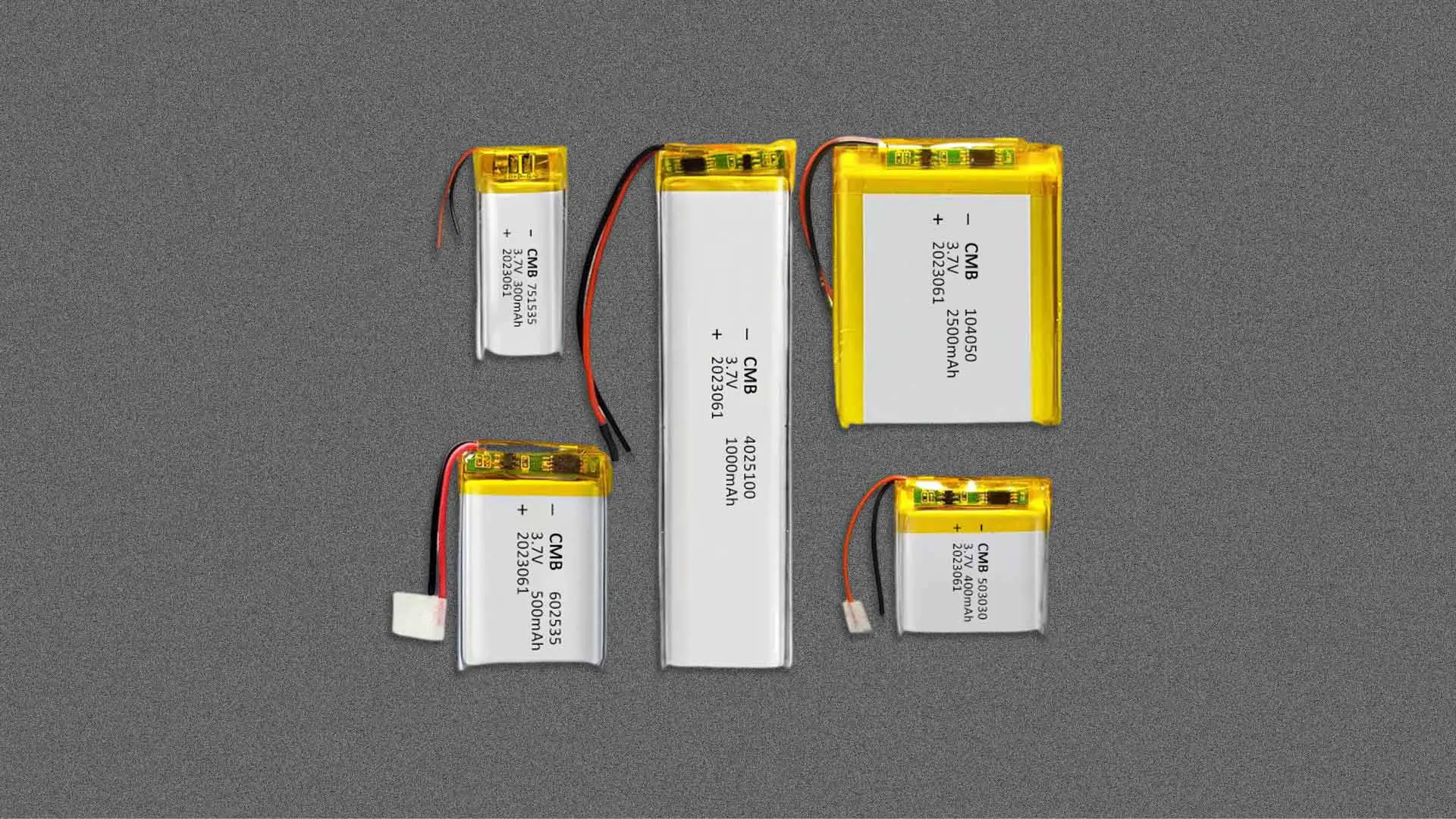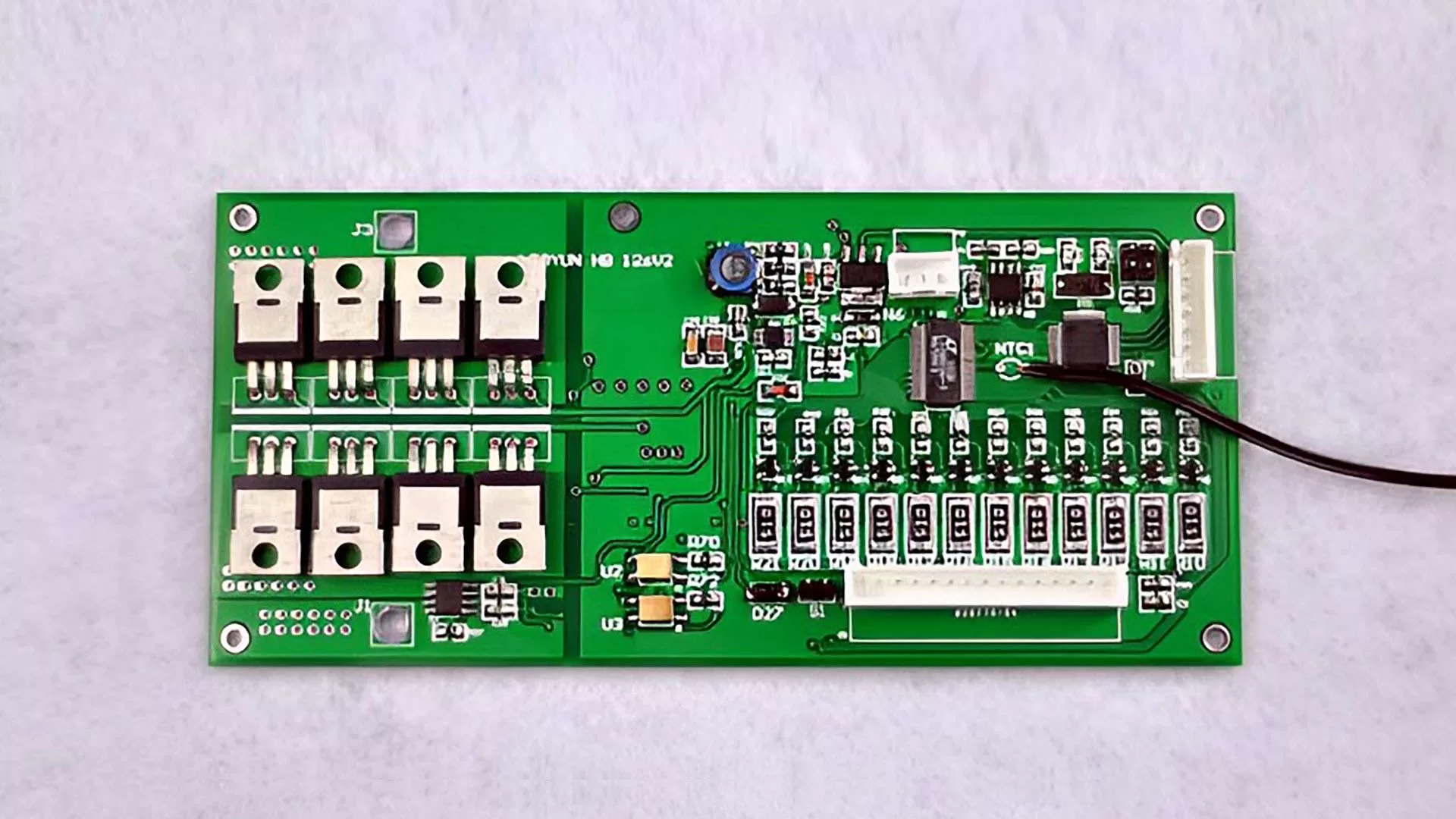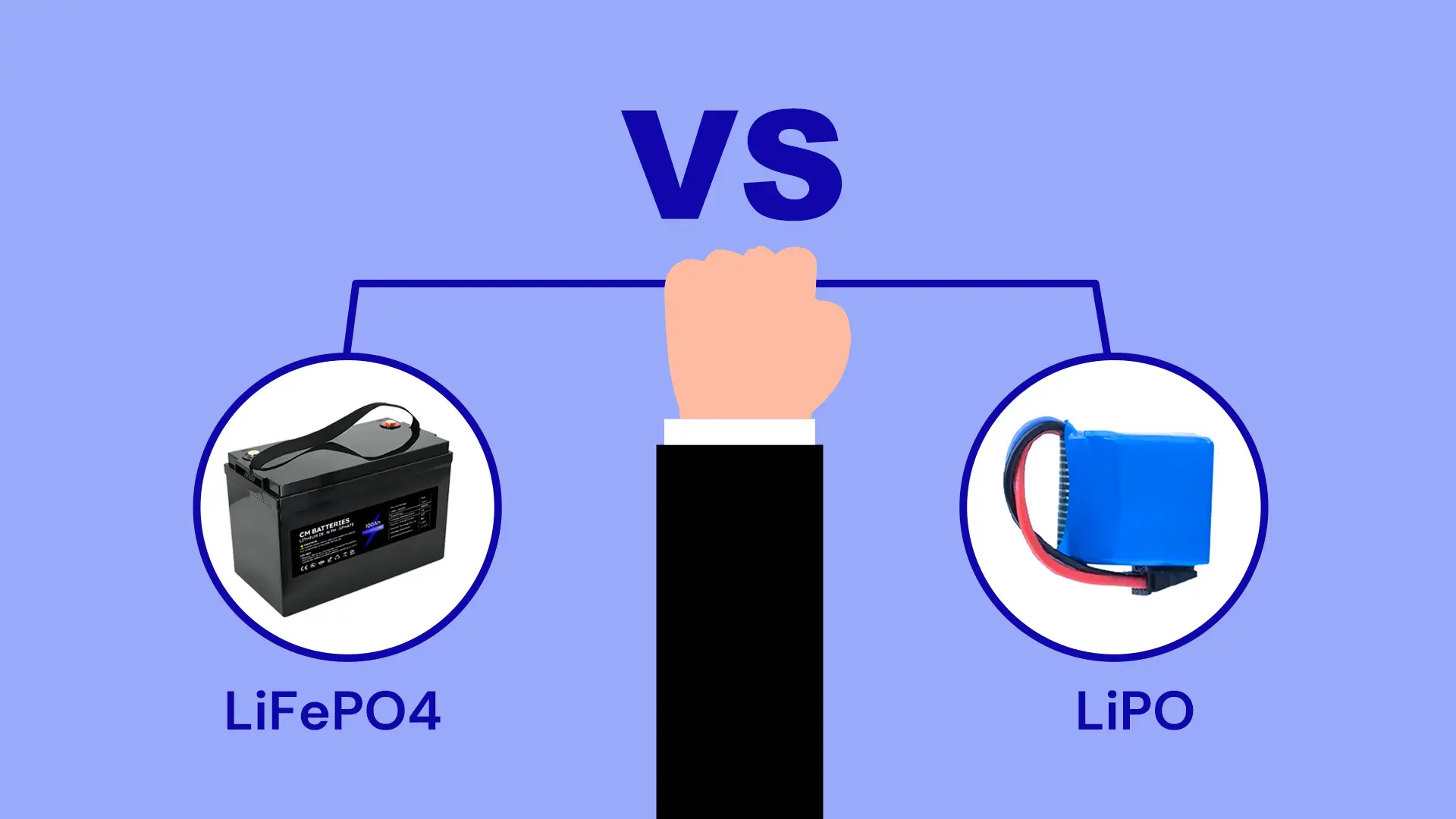Choosing between NiMH (Nickel-Metal Hydride) and LiPo (Lithium Polymer) batteries depends on your needs. Consider power, safety, budget, and application. This guide helps you choose based on performance data and expert advice.
Quick Decision Framework:
- Choose LiPo if you need: High power output, lightweight design, long runtime, or custom shapes.
- Choose NiMH if you prioritize: Safety, budget-friendly options, simple maintenance, or environmental friendliness.
What’s the Difference Between LiPo VS NiMH Battery?
They differ in chemistry, voltage, self-discharge rate, discharge rate, safety, cycle life, energy density, structure, and cost. Understanding their differences helps choose a battery based on performance and budget needs, ensuring efficiency and extended runtime of devices.

| Feature | LiPo battery | NiMH battery |
| Weight | light | heavy |
| Voltage per cell | 3.6V-3.8V | 1.2V |
| Structure | flexible customization | fixed design |
| Energy Density | high(200-350Wh/kg) | moderate(60-140Wh/kg) |
| Self-discharge Rate | 3%-5% per month | 10%-20% per month |
| Discharge Rate | High(30C-50C) | Low(2C-5C) |
| Cycle life | 300-500 cycles | 500-1000 cycles |
| Cost | expensive | affordable |
| Charging time | fast | slow |
| Safety | need PCB protection | high safety |
| Maintainance | complex | simple |
Chemistry
LiPo battery’s negative electrode is made of graphite, while its positive electrode materials are rich, covering lithium cobalt oxide and ternary materials. Its electrolyte uses solid polymer electrolyte, which can be either in a dry or gel state.
NiMH battery’s positive electrode uses nickel oxide hydroxide (NiOOH), and its negative electrodes use a hydrogen-absorbing alloy, according to Wikipedia.org.
Voltage
LiPo battery’s nominal voltage is 3.7V, and its voltage is increased by series, such as 7.4V, 11.1V, 14.8V
NiMH battery’s nominal voltage is 1.2V. A series of 6 NiMH batteries, and the voltage reaches 7.2V.
Self-discharge Rate
NiMH batteries have a high self-discharge rate and lose 10%-20% of power per month, whereas LiPo batteries’s low self-discharge about 3%-5%.
Discharge Rate
LiPo battery boosts for its high discharge rate up to 30C-50C, delivering large current instantly, providing great power for high-drain devices, such as power tools, drones.
However, NiMH battery’s discharge rate is low and reaches 5C, and the power output is mild.
Safety
LiPo battery suffers from swelling when overcharging or the temperature exceeds 70℃, which requires PCB board protection. NiMH batteries are safer than polymer batteries. NiMH battery has firm construction and is quite safe even if it is hit or penetrated.
Cycle Life
NiMH battery possesses a longer cycle life than a LiPo battery. A standard NiMH battery has 500-1000 cycle life, whereas a 3.7V LiPo battery has 300-500 cycle life.
That’s because NiMH batteries have a stable chemical structure and are tolerant to overcharge, temperature changes. In contrast, a high discharge rate leads to increased battery temperature and violent chemical reactions, which reduce the cycle life of LiPo batteries.
Energy Density
LiPo batteries feature with higher energy density than NiMH batteries, store more energy, and run longer. LiPo batteries feature with superior energy density of 200-350Wh/kg, providing longer runtime and stronger power with a compact size. However, NiMH batteries have a lower energy density from 60-140Wh/kg, which results in a shorter operating time.
Form and Structure
NiMH batteries have a fixed shape and are thick, with more than 3.6mm in thickness. LiPo batteries are more flexible than NiMH batteries because they can be customized into various shapes, such as ultra-thin or curved batteries. LiPo batteries leverage aluminum-plastic packaging film as the shell, which is lighter, thinner.
Cost
NiMH battery’s purchase cost is low, but its energy density is low. It needs to be replaced frequently, which increases the cost of use. LiPo battery’s raw material is expensive, but its high energy density delivers more power. Hence, its life cycle cost is low in the long run.
Advantages and Disadvantages of NiMH VS LiPo Battery
Here’s a straightforward comparison of the pros and cons of LiPo and NiMH batteries. This will assist OEMs, hobbyists, and engineers in making informed choices.
Key Advantages of LiPo Battery
- High energy density: Stores 2-3 times more energy per kilogram than NiMH batteries.
- Thin and light design: Critical for drones, RC vehicles, and portable electronics.
- Flexible customization: Can be manufactured in custom shapes to fit tight spaces.
- Low self-discharge rate: Retains 95-97% charge after one month of storage.
- High discharge rate: Deliver 30C-50C discharge rates for power-hungry applications.
- Fast Charging: Complete charging in 1-2 hours with proper chargers.
Key Advantages of NiMH Battery
- Lower cost: 50-70% less expensive than equivalent LiPo batteries.
- Environmentally friendly: Contain no toxic heavy metals, easier to recycle.
- High safety: No risk of thermal runaway or fire when damaged.
- Long cycle life: Withstand 500-1000 charge cycles with proper care.
- Simple Maintenance: No special charging or protection circuits are needed.
Disadvantages of LiPo Battery
- High cost: LiPo batteries have a complex production process, and raw materials are expensive, which makes them more expensive than NiMH batteries.
- Strict temperature and humidity control. High temperature affects the life of the LiPo battery, while low temperature reduces battery capacity.
- Safety hazards: LiPo batteries are susceptible to thermal runaway when impacted, squeezed, or experiencing internal failure.
Disadvantages of NiMH battery
- Low energy density: NiMH batteries have lower energy density compared with LiPo batteries. NiMH batteries store less energy due to chemical materials and technical design, bringing a shorter battery lifespan.
- Memory effect: NiMH Battery exhibits a memory effect if it is charged without full discharge, decreasing battery capacity. It affects the NiMH battery’s service life and performance.
- Slow charging speed: The Charging speed of NiMH batteries is slow, which affects the user’s efficient use.
What are the Applications of NiMH VS LiPo Battery?
Choose NiMH Batteries For:
Low-Budget Applications. The remote control or toys prefer to use NiMH batteries, which are cheap at only $1.5.
Low Energy and High-Safety Applications. NiMH batteries are more stable in low-power devices and are suitable for electric toothbrushes.
Easy-to-Maintain Applications. Correct charging, avoiding over-discharge, extends the life of NiMH batteries. NiMH batteries do not have complex PC boards like LiPo batteries.
Choose LiPo Batteries For:
High-drain devices that require longer runtime. Drones and RC cars leverage LiPo batteries with a high energy density of up to 200Wh/kg to achieve longer operating times.
Flexible shape or size customized devices. LiPo batteries can be customized into square, long strip, and L-shaped shapes to fit devices with compact sizes, such as medical devices or smart watches.
Lightweight smart devices. Lightweight is one of the biggest advantages of LiPo batteries and is widely used in wearable devices. AR glasses Leion Hey2 use LiPo batteries, weighing 49g and lasting up to 8 hours.

Which is the Best Battery for RC Cars: LiPo VS NiMH?
In RC car applications, LiPo battery offers longer runtime than NiMH battery for its superior energy density.
LiPo batteries for RC Cars
- Runtime: 25-30 minutes of hard driving with a 5000mAh pack.
- Speed: Higher voltage (7.4V, 11.1V) enables 40-60+ mph speeds.
- Weight Advantage: 30-40% lighter than similar NiMH packs.
- Power Delivery: Instant throttle response due to high discharge rates.
NiMH batteries for RC Car
- Consistent Power: Stable voltage output throughout discharge cycle.
- Durability: Withstand crashes and impacts without safety concerns.
- Cost Savings: 50-60% less expensive for equivalent capacity.
- Beginner-Friendly: No fire risk or explosion risk with improper handling.
How to Choose Between NiMH and LiPo Battery?
For Maximum Performance (Choose LiPo):
If you need the best power-to-weight ratio, go for LiPo batteries. They offer unmatched runtime and custom shapes. Industries like aerospace, photography, and racing depend on LiPo technology.
For Reliability and Safety (Choose NiMH):
If safety and cost are key, choose NiMH batteries. They are known for reliability. NiMH is great for consumer electronics and emergency gear, where failure isn’t an option.
FAQs About NiMH VS LiPo Battery
Can I replace NiMH with LiPo in my device?
Sometimes, but not always. Ensure the device supports the voltage and charging specs of LiPo batteries.
Which lasts longer—NiMH or LiPo Battery?
NiMH lasts longer in charge cycles if well maintained. LiPo gives better runtime per charge but wears out faster.
Are LiPo batteries dangerous?
Only if not used properly. Good charging, storage, and handling make them safe to use.
Conclusion
Choosing between NiMH and LiPo batteries depends on your needs for performance, safety, budget, and usage. LiPo batteries are best for high-performance tasks needing lightweight and power. NiMH batteries are reliable, safe, and cost-effective for daily use.
Think about your device’s power needs, safety requirements, budget, and maintenance when making your choice. Both battery types keep improving, with manufacturers working to reduce their downsides while boosting their strengths. Need help selecting the right battery chemistry? Get in touch with CM Batteries for expert consultation and rapid prototyping.







